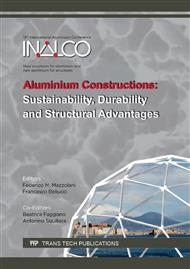[1]
G. De Matteis, A. Formisano, F.M. Mazzolani, S. Panico, Design of low-yield metal shear panels for energy dissipation, Improvement of Buildings' Structural Quality by New Technologies, Proc. of the Final Conference of COST Action C12, 2005, 665-675.
DOI: 10.1201/9780203970843.ch77
Google Scholar
[2]
A. Formisano, F. M. Mazzolani, G. Brando, G. De Matteis, Numerical evaluation of the hysteretic performance of pure aluminium shear panels, The 5th International Conference on Behaviour of Steel Structures in Seismic Areas (STESSA '06), Yokohama, Japan, (2006).
DOI: 10.1201/9780203861592.ch120
Google Scholar
[3]
A. Formisano, F. M. Mazzolani, F. M., G. De Matteis, Numerical Analysis of Slender Steel Shear Panels for Assessing Design Formulas, International Journal of Structural Stability & Dynamics, 7 (2007) 273-294.
DOI: 10.1142/s0219455407002289
Google Scholar
[4]
M. Xue, L. W. and Lu, Interaction of infilled steel shear wall panels with surrounding frame members. Proc. of 1994 Annual Task Group Technical Session, Structural Stability Research Council: reports on current research activities, Lehigh University, Bethlehem, PA, (1994).
Google Scholar
[5]
T. Hitaka, T., C. Matsui, Experimental study on steel shear wall with slits, Journal of Structural Engineering (ASCE), 129(5) (2003) 586-595.
DOI: 10.1061/(asce)0733-9445(2003)129:5(586)
Google Scholar
[6]
J. W. Berman, M. Bruneau, Experimental investigation of light-gauge steel plate shear walls, Journal of Structural Engineering (ASCE), 131(2) (2005) 259-267.
DOI: 10.1061/(asce)0733-9445(2005)131:2(259)
Google Scholar
[7]
E. S. Mistakidis, G. De Matteis, A. Formisano, Low yield metal shear panels as an alternative for the seismic upgrading of concrete structures, Advances in Engineering Software, 38 (2007) 626-636.
DOI: 10.1016/j.advengsoft.2006.08.043
Google Scholar
[8]
R. Purba, M. Bruneau, Design recommendations for perforated steel plate shear walls (Technical Rep. No. MCEER-07-0011). Multidisciplinary Center for Earthquake Engineering Research, State University of New York, Buffalo, N.Y., (2007).
Google Scholar
[9]
A. Formisano, G. De Matteis, F.M. Mazzolani, Numerical and experimental behaviour of a full-scale RC structure upgraded with steel and aluminium shear panels, Computers and Structures, 88 (23-24) (2010) 1348-1360.
DOI: 10.1016/j.compstruc.2008.09.010
Google Scholar
[10]
Dassault Systèmes, ABAQUS 6. 10. Simulia Corp., Providence, RI, USA, (2010).
Google Scholar
[11]
H. Valizadeh, M. Sheidaii, H. Showkati, Experimental investigation on cyclic behaviour of perforated steel plate shear walls, Journal of Constructional Steel Research, 70 (2012) 308-316.
DOI: 10.1016/j.jcsr.2011.09.016
Google Scholar
[12]
G. De Matteis, A. Formisano, F. M. Mazzolani, S. Panico, Numerical and experimental analysis of pure aluminium shear panels with welded stiffeners, Computers & Structures, 30 (2008) 545-555.
DOI: 10.1016/j.compstruc.2007.05.027
Google Scholar
[13]
A. Formisano, G. De Matteis, S. Panico, B. Calderoni, F. M. Mazzolani, Full-scale test on existing RC frame reinforced with slender shear steel plates, Proc. of the 5th International Conference on Behaviour of Steel Structures in Seismic Areas - Stessa 2006, pp.827-834, (2006).
DOI: 10.1201/9780203861592.ch34
Google Scholar
[14]
A. Formisano, G. De Matteis, S. Panico, F. M. Mazzolani, Full scale test of an existing RC frame reinforced with pure aluminium shear panels, Proc. of the International Colloquium on Stability and Ductility of Steel Structures, SDSS 2006, pp.903-910, (2006).
DOI: 10.1016/j.compstruc.2008.09.010
Google Scholar
[15]
A. Formisano, G. De Matteis, S. Panico, F. M. Mazzolani, Seismic upgrading of existing RC buildings by slender steel shear panels: A full-scale experimental investigation, Advanced Steel Construction, 4 (1) (2008) 26-45.
DOI: 10.4203/ccp.85.73
Google Scholar
[16]
G. De Matteis, A. Formisano, F. M. Mazzolani, RC structures strengthened by metal shear panels: Experimental and numerical analysis, AIP Conference Proceedings, 1020 (Part 1), pp.27-34, (2008).
DOI: 10.1063/1.2963846
Google Scholar
[17]
G. De Matteis, A. Formisano, F.M. Mazzolani, An innovative methodology for seismic retrofitting of existing RC buildings by metal shear panels, Earthquake Engineering and Structural Dynamics, 38 (1) (2009) 61-78.
DOI: 10.1002/eqe.841
Google Scholar
[18]
A. Formisano, L. Lombardi, Numerical prediction of the non-linear behaviour of perforated metal shear panels, Cogent Engineering, 3: 1156279 (2016) 1-16, http: /dx. doi. org/10. 1080/23311916. 2016. 1156279.
DOI: 10.1080/23311916.2016.1156279
Google Scholar


